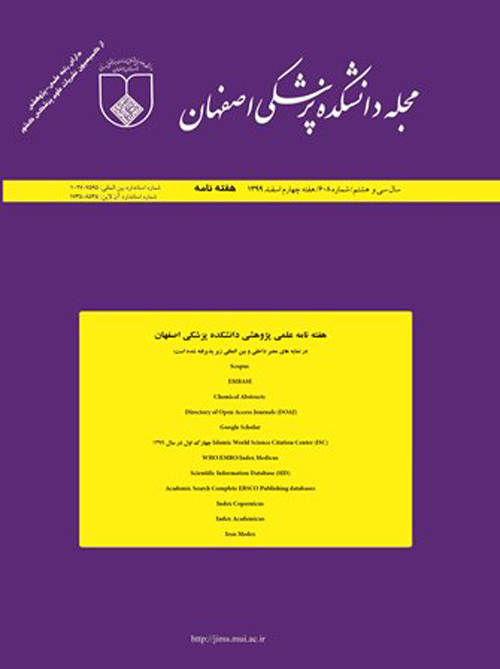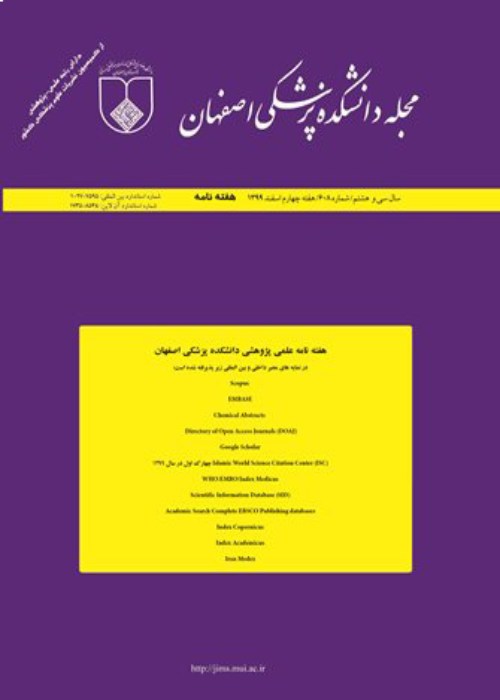فهرست مطالب

مجله دانشکده پزشکی اصفهان
پیاپی 648 (هفته چهارم دی 1400)
- تاریخ انتشار: 1400/10/28
- تعداد عناوین: 3
-
-
صفحات 826-834مقدمه
پزشکان عمومی بیشترین یادگیری خود را در چرخشهای داخلی و جراحی کسب میکنند. پژوهش حاضر با هدف بررسی وضعیت موجود آموزش در بخشهای بستری در گروههای داخلی و جراحی از دیدگاه دانشجویان انجام شد تا با تعیین نقاط قوت و ضعف و بهترین مکان و شخص آموزش دهنده، به بهبود آموزش کمک شود.
روشهااین مطالعه از نوع مقطعی بود که در بیمارستان الزهرای (س) اصفهان انجام گردید. جامعهی هدف متشکل از کارآموزان سال تحصیلی 98-1397 در دو گروه داخلی و جراحی بود که به روش در دسترس وارد تحقیق شدند. برای جمعآوری دادهها، از ابزار محقق ساخته استفاده گردید. سپس دادهها به صورت میانگین و انحراف معیار و تعداد (درصد) گزارش شد.
یافتههااز 260 پرسشنامه، 154 مورد تکمیل گردید (درصد پاسخگویی: 60 درصد). بیشترین میانگین درصد دستیابی به مهارتهای هفتگانه در هر دو گروه داخلی (64/21 ± 71/68) و جراحی (98/27 ± 95/56)، مهارت شرححالگیری بود و کمترین درصد دستیابی در هر دو گروه داخلی (81/20 ± 20/23) و جراحی (44/26 ± 37/13)، به مهارتهای عملی اختصاص یافت. مناسبترین فرد و مکان برای آموزش تمام مهارتها به جزء مهارتهای عملی، استاد و بر بالین بیمار بود. برای مهارتهای عملی نیز تمرین و تجربهی شخصی کارآموزان در بالین مناسب شناخته شد.
نتیجهگیریمیزان دستیابی به مهارت در حیطههای مختلف آموزش بالینی پایین بود و پایینترین نتایج مربوط به حیطه «مهارتهای عملی» میباشد. به نظر میرسد آموزش بر بالین بیمار و توسط استاد، بیشترین نقش را در افزایش مهارت کارآموزان در حیطههای مختلف دارد. انجام مطالعات بیشتر جهت تعیین دقیق شاخصهای موثر بر میزان دستیابی به مهارتهای بالینی توسط کارآموزان احساس میگردد.
کلیدواژگان: آموزش پزشکی، داخلی، جراحی، دانشجویان پزشکی -
صفحات 835-841مقدمه
مواد غذایی گوناگون، تاثیرات متفاوتی بر عملکردهای مغزی میگذارند. پژوهش حاضر با هدف بررسی تاثیر مصرف حاد، تحت مزمن و مزمن ساکارز و انواع شکلات (با درصد متفاوت کاکایو و کربوهیدرات) به عنوان مواد غذایی پرطرفدار بر اضطراب، فعالیت حرکتی، مصرف غذا و اختلاف وزن در موشهای صحرایی نر بررسی گردید.
روشها35 موش صحرایی نر نژاد ویستار (وزن 250-200 گرم) در پنج گروه آزمایشی مصرف غذای استاندارد (شاهد)، شکلات تلخ، شکلات شیری، شکلات سفید و ساکارز قرار گرفتند و برای مدت 14 روز بررسی شدند. سطح اضطراب و میزان فعالیت حرکتی در روزهای 1، 7 و 14 با استفاده از آزمون میدان باز ارزیابی و سپس میزان مصرف غذا و تغییرات وزن اندازهگیری گردید.
یافتههامصرف تحت مزمن ساکارز و شکلات سفید، سبب کاهش معنیدار تعداد کل عبور از خانههای میدان باز نسبت به گروه شاهد شد. مصرف حاد ساکارز نیز منجر به کاهش معنیدار تعداد عبور از خانهی مرکزی گردید. مصرف تحت مزمن شکلات تلخ، سبب افزایش معنیدار عبور از خانههای مرکزی شد. در رژیمهای تک غذایی متفاوت، میزان مصرف غذا، کاهش معنیداری در تمامی گروههای آزمایشی نسبت به گروه شاهد داشت. در تمام انواع رژیم غذایی، تغییرات وزن طی هفت روز ابتدایی، کاهش معنیداری را در همهی گروهها نشان داد. همچنین، تغییرات وزن در طی هفت روز نهایی در گروههای ساکارز، شکلات شیری و شکلات تلخ کاهش معنیداری را نشان داد.
نتیجهگیریاضطراب با مصرف تحت مزمن شکلات تلخ و مصرف حاد ساکارز، کاهش چشمگیری مییابد. مصرف تحت مزمن ساکارز و شکلات سفید، سبب کاهش فعالیت حرکتی نمونهها شد. از طرف دیگر، رژیم تک غذایی صرف نظر از نوع مادهی غذایی، توانست سبب کاهش وزن قابل توجه شود. البته رژیم تک غذایی شکلات با میزان بیشتر کاکایو، منجر به کاهش وزن بیشتر گردید.
کلیدواژگان: اضطراب، شکلات، ساکارز، رژیم، موش صحرایی -
صفحات 842-851مقدمه
سوختگی از جمله پرهزینهترین و پرعارضهترین آسیبها به شمار میرود. زخمهای سوختگی حتی اگر غیر کشنده باشند، میتوانند بدترین آثار جسمی، روانی، اجتماعی و اقتصادی را به دنبال داشته باشند. پماد سیلور سولفادیازین به عنوان استاندارد طلایی در مدیریت زخم سوختگی به کار میرود. مطالعات مختلف، نتایج متفاوتی در خصوص مقایسهی هزینه- اثربخشی استفاده از پماد سیلور سولفادیازین با پانسمانهای جدید حاوی نانوذرات نقره ارایه کردهاند. هدف از انجام پژوهش حاضر، مقایسهی هزینه- اثربخشی استفاده از پانسمان نانوکریستال نقره در مقایسه با سیلور سولفادیازین در التیام زخم سوختگی بود.
روشهااین تحقیق بر اساس طرح ارزیابی فنآوری سلامت، مصوب موسسهی تحقیقات ملی سلامت ایران انجام گرفت. از روش مرور نظاممند و جستجو در پایگاههای PubMed، Scopus، ProQuest، UpToDate، IranMedex و Scientific Information Database (SID) به منظور مقایسهی هزینه- اثربخشی پانسمان نانوکریستال نقره با پماد سیلور سولفادیازین استفاده شد. از آنجا که امکان انجام متاآنالیز با توجه به تنوع مطالعات بررسی شده از نظر روششناسی و محدویت تحقیقات متناسب با سوال پژوهش وجود نداشت، از مرور روایتی جهت تحلیل نتایج مقالات منتشر شده طی سالهای 1990 تا 2017 استفاده گردید.
یافتههادر جستجوی اولیه از پایگاههای اطلاعاتی، 213 مقاله یافت شد که 60 مقاله به دلیل تکراری بودن، حذف و 153 مقاله انتخاب و پس از مرور عناوین و چکیده، 122 مقاله خارج گردید. از 31 مقالهی متن کامل، بر اساس معیار ورود، 13 مقاله وارد مطالعه شد. نتایج به دست آمده در خصوص اثربخشی پانسمان نانوکریستال نقره نشان داد که عفونت زخم، درد، زمان التیام، نیاز به بازسازی بافتی، انجام جراحی پیوند پوست و طول مدت بستری در مقایسه با سیلور سولفادیازین کمتر میباشد. همچنین، درمان با پانسمان نانوکریستال نقره در مقایسه با سیلورسولفادیازین کمهزینهتر است.
نتیجهگیریدرمان با پانسمان نانوکریستال نقره در مقایسه با سیلور سولفادیازین موثرتر میباشد و هزینهی کمتری دارد. در عین حال، با توجه به تعداد محدود مقالات در راستای اهداف مطالعه، تصمیمگیری قطعی در زمینهی هزینه- اثربخشی و در نتیجه، پیشنهاد برای جایگزینسازی این پانسمان، نیاز به انجام پژوهشهای بیشتری دارد.
کلیدواژگان: نانوکریستال نقره، سیلور سولفادیازین، التیام زخم، سوختگی، پانسمان، بیمار
-
Pages 826-834Background
General practitioners acquire most of their learning in internal and surgical departments. The purpose of this study was to determine the current status of education in these departments from the students` point of view to help improve clinical education.
MethodsThis was a cross-sectional study conducted in Alzahra hospital in Isfahan, Iran. The target population consisted of clerkships in two departments of internal medicine and surgery in the academic year of 2017-2018. A researcher-made tools was used to collect data, and after completion by the clerkships, data were reported descriptively. Quantitative data were reported as mean ± standard deviation and qualitative number (percent).
FindingsOut of 260 questionnaires, 154 were completed (response rate of 60%). The highest mean percentage of achievement of clinical skills in both internal (68.71 ± 68.71) and surgical (56.95 ± 27.98) groups was history taking, and the lowest in both internal (20.81 ± 23.20) and surgical (26.44 ± 13.37) groups was practical skills. The most suitable person/place to teach all the skills, except the practical skills, was the teachers/on the bed, and for the practical skills, was practice and personal experience/on the bed.
ConclusionThe level of clinical skills acquisition is not desirable, and the lowest results are related to practical skills. It seems that bedside teaching by the clinical teachers has played the most important role in increasing the skills of clerkship in various fields. Further studies are needed to determine the exact factors affecting the achievement of clinical skills.
Keywords: Medical education, Internal medicine, Surgery, Medical students -
Pages 835-841Background
Different nutrients affect brain functions. This research investigated the effects of acute, sub-chronic, and chronic consumption of sucrose and different kinds of chocolate (with various cocoa and carbohydrate percentage) as portable nutrients on anxiety, locomotor activity, food consumption, and body weight differences (BWD) in male rats.
MethodsThirty-five male Wistar rats (200-250 g) were divided into five experimental groups: standard food (control), dark chocolate, milk chocolate, white chocolate, and sucrose for 14 days. Anxiety and locomotor activities were evaluated on days 1,7, and 14 using open field test (OFT). Then, food consumption and BWD were measured.
FindingsThe sub-chronic consumption of sucrose and white chocolate significantly decreased total crossing number of OFT compared to control group. Moreover, acute consumption of sucrose tended to significant decreases in central crossing number. The sub-chronic dark chocolate consumption showed a significant enhancement of central crossing number. In different mono-diet of nutrients, the food consumption showed significant decreases in all groups compared to control group. The BWD had significant decreases in the first seven days. In addition, The BWD showed significant decreases in sucrose, milk chocolate, and dark chocolate during the final seven days.
ConclusionAnxiety significantly decreased by sub-chronic consumption of dark chocolate and acute sucrose consumption. Moreover, sub-chronic sucrose and white chocolate consumption decreased locomotor activity in subjects. While, regardless of nutrient types, the mono-diet could cause major weight loss. Further weight loss occurred with a high concentration of cocoa in the dark chocolate mono-diet.
Keywords: Anxiety, Chocolate, Sucrose, Diet, Rats -
Pages 842-851Background
Burn is one of the costliest and most harmful damages. Burn wounds, even if they are non-lethal, can have the worst physical, psychological, social, and economic effects. Silver sulfadiazine ointment is the gold standard for wound management burns. However, different studies have shown different results in comparing the use of silver sulfadiazine ointment with new dressings containing silver nanoparticles. The purpose of this study was to compare the-cost effectiveness of silver nanocrystal dressing with silver sulfadiazine in burn wound healing.
MethodsThis research was based on the Health Technology Assessment Plan approved by the National Health Research Institute of Iran. Using the systematic review method, the PubMed, Scopus, Proquest, Google Scholar, Cochrane, Up To Date, Iranmedex, and Scientific Information Database (SID) databases were used to compare the effectiveness and cost of silver nanocrystal with silver sulfadiazine ointment. Considering the diversity of studies in terms of methodology and the limitation of studies appropriate to the research question, since there was no possibility of meta-analysis, narrative review was used to analyze the results of the studies during the years1990 to 2017.
FindingsIn the initial search of the databases, 213 articles were found; of which, 60 articles were deleted due to duplication, and 153 studies were selected After reviewing the titles and abstracts,122 studies were excluded. Out of 31 full-text articles, 13 articles were finally included in the study. The results of analysis showed that wound infection, healing time, pain, need to skin grafts, and duration of hospitalization were less than that for silver nanocrystals compared to sulfadiazine. Moreover, the cost of treatment for silver nanocrystals was lower than that of silver sulfadiazine.
ConclusionTreatment with silver nanocrystals is more effective and less costly than silver sulfadiazine. Given to the limited number of the articles in line with the objectives of the study, it is necessary to perform further studies before finalizing any decision regarding the cost-effectiveness and making suggestions to replace the dressing.
Keywords: Silver Sulfadiazine, Nanoparticles, Burns, Wound healing, Bandages, Cost effectiveness


